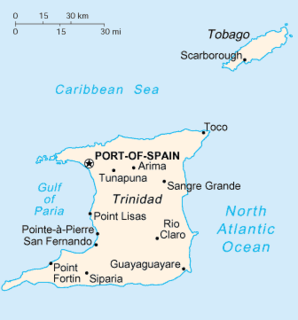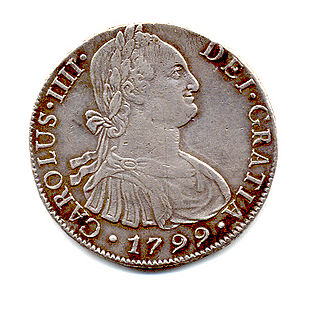
The Eastern Caribbean dollar is the currency of all seven full members and one associate member of the Organisation of Eastern Caribbean States (OECS). The successor to the British West Indies dollar, it has existed since 1965, and it is normally abbreviated with the dollar sign $ or, alternatively, EC$ to distinguish it from other dollar-denominated currencies. The EC$ is subdivided into 100 cents. It has been pegged to the United States dollar since 7 July 1976, and the exchange rate is US$1 = EC$2.70.
The British West Indies dollar (BWI$) was the currency of British Guiana and the Eastern Caribbean territories of the British West Indies from 1949 to 1965, when it was largely replaced by the East Caribbean dollar, and was one of the currencies used in Jamaica from 1954 to 1964. The monetary policy of the currency was overseen by the British Caribbean Currency Board (BCCB). The British West Indies dollar was never used in British Honduras, the Cayman Islands, the Turks and Caicos Islands, the Bahamas, or Bermuda.
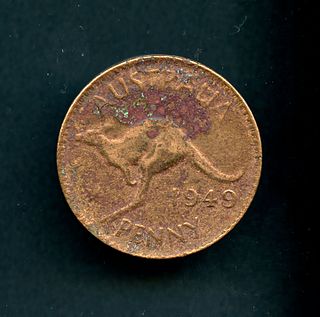
Australian coins refers to the coins which are or were in use as Australian currency. During the early days of the colonies that formed Australia, foreign as well as British currency was used, but in 1910, a decade after federation, Australian coins were introduced. Australia used pounds, shillings and pence until 1966, when it adopted the decimal system with the Australian dollar divided into 100 cents. With the exception of the first Proclamation Coinage and the holey dollars, all Australian coins remain legal tender despite being withdrawn from circulation.

The dollar is the currency of Trinidad and Tobago. It is normally abbreviated with the dollar sign $, or alternatively TT$ to distinguish it from other dollar-denominated currencies. It is subdivided into 100 cents. Its predecessor currencies are the Trinidadian dollar and the Tobagonian dollar.

Holey dollar is the name given to coins used in the early history of two British settlements: Prince Edward Island and New South Wales. The middle was punched out of Spanish dollars, creating two parts: a small coin, known as a "dump" in Australia, and a "holey dollar". This coin was one of the first coins struck in Australia.
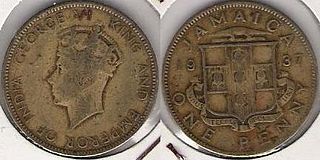
The Jamaican pound was the official currency of Jamaica between 1840 and 1969. It circulated as a mixture of British currency and local issues and was always equal to the British pound. The Jamaican pound was also used by the Cayman Islands and Turks and Caicos Islands.
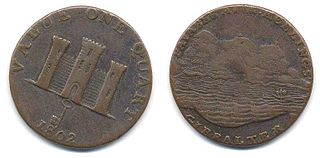
The real was the official currency of Gibraltar until 1825 and continued to circulate alongside other Spanish and British currencies until 1898.
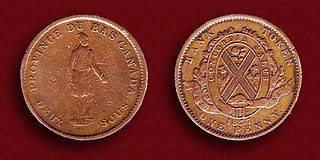
The pound was the unit of account for currency of the Canadas until 1858. It was subdivided into 20 shillings (s), each of 12 pence (d). In Lower Canada, the sou was used, worth 1⁄2 penny. Although the pounds, shillings, and pence accounting system had its origins in the British pound sterling, the Canadian pound was never formally linked to the British currency.

The pound was the currency of the Commonwealth of Massachusetts and its colonial predecessors until 1793. Like the British pound sterling of that era, the Massachusetts pound was subdivided into 20 shillings, each of 12 pence, but the Massachusetts and British pounds were not equivalent in value. British and other foreign coins were widely circulated in Massachusetts, supplemented by locally produced coins between about 1652 and 1682 and by local paper money from 1690.

The pound was the currency of Rhode Island until 1793. Initially, the British pound and foreign coins circulated, supplemented by local paper money from 1710. These notes were denominated in pounds, shillings, and pence, but they were worth less than sterling, with 1 Rhode Island shilling = 9 pence sterling. The first issue of notes was known as the "Old Tenor" issue. This fell in value and "New Tenor" notes were introduced in 1740, worth four times the Old Tenor notes. Both Old and New Tenor notes were replaced in 1763 by "Lawful money" at a rate of 1 Lawful shilling = 6⅔ New Tenor shillings = 26⅔ old Tenor shills.

The pound was the currency of Virginia until 1793. Initially, the British pound sterling circulated along with foreign currencies, supplemented from 1755 by local paper money. Although these notes were denominated in pounds, shillings and pence, they were worth less than sterling, usually discounted so 1 Virginia shilling was equal to 9 British pence, while 1 British shilling was equal to 12 British pence. In British pounds, shillings and pence (£sd), duodecimal coinage, which was in use in the UK until the adoption of decimal coinage in 1971.
The pound was the currency of Bermuda until 1970. It was equivalent to the pound sterling, alongside which it circulated, and was similarly divided into 20 shillings each of 12 pence. Bermuda decimalised in 1970, replacing the pound with the Bermudian dollar at a rate of 1 dollar = 8 shillings 4 pence, equal to the U.S. dollar.
The history of currency in the British colony of Dominica closely follows that of the British Eastern Caribbean territories in general. Even though Queen Anne's proclamation of 1704 brought the gold standard to the West Indies, silver pieces of eight continued to form a major portion of the circulating currency right into the latter half of the nineteenth century.
The history of currency in the British colony of Grenada closely follows that of the British Eastern Caribbean territories in general. Even though Queen Anne's proclamation of 1704 brought the gold standard to the West Indies, silver pieces of eight continued to form a major portion of the circulating currency right into the latter half of the nineteenth century.
The history of currency in the British colony of St. Kitts closely follows that of the British Eastern Caribbean territories in general. Even though Queen Anne's proclamation of 1704 brought the gold standard to the West Indies, silver pieces of eight continued to form a major portion of the circulating currency right into the latter half of the nineteenth century.
The livre was the currency of Saint Lucia until 1814. The Saint Lucia livre was a French colonial currency, distinguished by the use of various cut Spanish and Spanish colonial coins. The livre was subdivided into 20 sous, each of 12 deniers. The escalin was worth 15 sous, with the stampee worth 3 sous 9 denier. Until 1813, 12 escalins were equal to 8 reales, after which 15 escalins equaled 8 reales. In 1851, sterling was introduced for circulation.
The history of currency in the British colony of Saint Vincent closely follows that of the British Eastern Caribbean territories in general. As such, it should not be considered in isolation. In order to get a broad overview of currency in the region, see the article British West Indies dollar.
The dollar was the currency of Tobago until 1814. The currency comprised various cut Spanish dollars and countermarked French colonial coins. The dollar was subdivided into 11 bits, each of nine pence. In 1814, sterling was established as the official currency of the island. Since 1905, dollars have once more circulated on Tobago, first the Trinidad and Tobago dollar, than the British West Indies dollar, before the Trinidad and Tobago dollar was reintroduced.
The livre was the currency of Guadeloupe until 1816. It was subdivided into 20 sous, each of 12 deniers, with the escalin worth 15 sous. The Guadeloupe livre was a French colonial currency, distinguished by the use, in part, of Spanish coins.
The pound was the currency of Prince Edward Island until 1871. It was subdivided into 20 shillings, each of 12 pence. It was replaced by the dollar in 1871. British coins circulated, together with locally produced coins and paper money.
